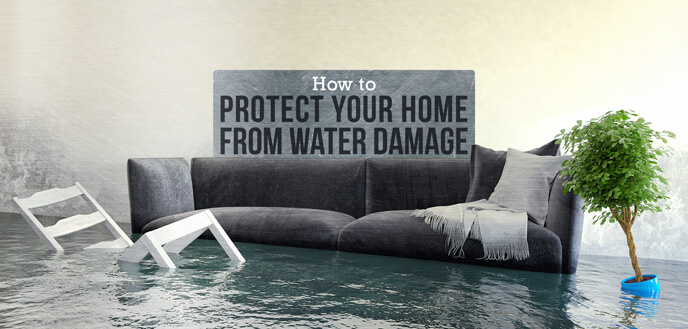Familiarize yourself with the different types of water damage, how you can prevent them and if they’re covered in a standard homeowner’s insurance policy. It’s important to review your policy with your insurance agent to understand what coverage you have in your policy and what coverages you may want to consider adding.
As a homeowner, one of the last things you want to deal with is water damage. Unfortunately, 14,000 people in the U.S. experience a water damage emergency at home or work each day. In addition, 98 percent of basements in the U.S. will experience some type of water damage during their lifespans.1 Water damage is typically messy, can be hazardous and depending on the root cause for the damage, a costly nightmare.
Familiarize yourself with the different types of water damage, how you can prevent them and if they’re covered in a standard homeowner’s insurance policy. It’s important to review your policy with your insurance agent to understand what coverage you have in your policy and what coverages you may want to consider adding.
1. Backup of sewers and drains/sump pump failure
Water damage can occur when there is a blockage or backup in sanitary sewer lines or if your sump pump fails. Unfortunately, this type of damage is not covered under a standard homeowner policy but can be purchased as additional coverage at a low cost.
There are many potential causes for a backup of the sewer line such as an aging sewer system with cracks in the pipe joints which allow tree roots to grow inside and create blockage or deterioration and collapse of the pipe itself. In addition, older municipal sewer pipelines could be combined with storm water pipelines, meaning rain, melting snow and raw sewage are all trying to pass through one pipe. At times, this may be too much for the pipe to handle, which can cause backup and overflow into a home.
Homeowners are responsible for the sewer pipeline attached to their home and for the sewer lateral – the section of the pipe from their home to the city sanitary sewer main, usually located in the street. To help prevent sewer water backups, make sure your pipelines are inspected and replaced as necessary. Properly dispose of garbage, paper products and cooking grease; none of these items should go down a sink drain or be flushed. In many instances, a sewer check valve (also called a backwater valve) can be installed to greatly reduce backwater escaping back into a house sewer.
Sump system failures can happen when there is excessive subsurface water during a storm or spring thaw. Overburdened pumps can breakdown. Ensure your sump pump is working properly; routinely inspect the discharge pipe connections and address any drainage issues outside the home. Consider installing a battery backup in case of power failure or a secondary pump should the primary one fail.
You can also reach out to a licensed professional plumber for advice and installation of plumbing and sump system components.
2. Overflowing water damage
Overflowing water damage can occur due to appliances, such as a washing machine or dishwasher, overflowing, as well as burst pipes. Some of the main causes of a burst pipe include frozen pipes, high water pressure and corrosion.2 These types of water damage are typically covered under a standard homeowner policy but can vary depending on if the incident was accidental or due to lack of maintenance.
Here are a few ways to prevent burst pipes in your home:
Frozen pipes – if you’re not going to be home, make sure to set your home temperature at 55 degrees or warmer when it’s cold/freezing outside.
Water pressure – make sure your water pressure is not too high by checking the pressure gauge. The average water pressure range should be between 40-45 pounds per square inch (psi), not exceeding 60 psi.3
Corrosion – although pipes should last a long time, hard water or a pH imbalance in your water may slowly start to deteriorate and corrode your pipes, increasing their likelihood of bursting.
Whether an appliance overflows or a pipe bursts, your first course of action should be to turn off the water. All family members should know where all water shut off valves are located. It’s also a good idea to completely shut off the water if you are going on vacation or leaving your house vacant for an extended period.
3. Flood water damage
The Federal Emergency Management Agency (FEMA) defines a flood as “overflow of inland or tidal waters, unusual and rapid accumulation or runoff of surface waters from any source, or mudflow4.” Flood insurance is not included in a standard homeowner’s policy. Contact your independent agent if you are interested in purchasing flood insurance; you cannot purchase it directly from the National Flood Insurance Program.
Floods can happen anywhere, anytime, and are the most common and costly natural disaster in the U.S. Of all the flood claims, more than 20 percent are from properties not located in high risk flood zones.4
Learn more about the National Flood Insurance Program through FEMA’s website.
If water damage occurs in your home, the most important thing you can do is clean up the mess properly and safely to avoid future mold issues. Mold remediation is not covered in a standard homeowner’s policy but can be purchased as additional coverage.
Always wet vacuum excess water, completely dry out or discard damaged carpet (you may need to use a dehumidifier to remove excess moisture from the air), disinfect and wash down all surfaces affected, and seal/repair any cracks. To ensure the mess has been cleaned up properly, you may want to call a professional.
Water damage can happen to any homeowner unexpectedly; it’s important to know when and how you’re covered. If you are unsure about your policy, contact The Agent Insurance Services today, even if you’re not insured with us! (330) 758-3339
Sources:
1 https://www.waterdamagedefense.com/pages/water-damage-by-the-numbers
2 https://www.rotorooter.com/plumbing-basics/frequently-asked-questions/plumbing-in-your-home/why-do-pipes-burst/
3 http://www.popularmechanics.com/home/how-to/a1053/4202333/
4 https://www.fema.gov/pdf/nfip/manual201105/content/22_definitions.pdf

